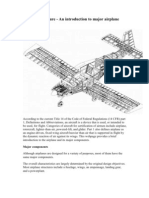Planes
Planes
Uploaded by
slovak.jaCopyright:
Available Formats
Planes
Planes
Uploaded by
slovak.jaCopyright
Available Formats
Share this document
Did you find this document useful?
Is this content inappropriate?
Copyright:
Available Formats
Planes
Planes
Uploaded by
slovak.jaCopyright:
Available Formats
Planes, also known as airplanes or aircraft, are vehicles designed for air
travel. They have played a transformative role in transportation, commerce,
and global connectivity. Here are key aspects of planes:
1. Types of Aircraft: There are various types of aircraft, each designed for
specific purposes. Commercial airliners transport passengers, cargo planes
carry goods, military aircraft serve defense purposes, and general aviation
includes private and recreational flying.
2. Components of an Aircraft:
Fuselage: The main body of the plane, housing the crew, passengers,
and cargo.
Wings: Provide lift and stability during flight.
Empennage (Tail Section): Includes the horizontal stabilizer, vertical
stabilizer, and rudder, contributing to stability and control.
Engines: Power the aircraft and generate thrust for propulsion.
Landing Gear: Supports the plane during takeoff and landing,
retracting during flight.
3. Principles of Flight:
Lift: Generated by the wings, opposing the force of gravity.
Thrust: Produced by the engines, moving the plane forward.
Drag: Resistance encountered as the plane moves through the air.
Gravity: The force pulling the aircraft downward.
4. Commercial Aviation: Commercial planes transport millions of
passengers globally each day. Major manufacturers include Boeing and
Airbus. Airlines operate a variety of models, such as the Boeing 737, Airbus
A320, and larger aircraft like the Boeing 747 or Airbus A380.
5. Military Aircraft: Military planes serve diverse roles, including fighters
for air combat (e.g., F-16), bombers for strategic attacks (e.g., B-2 Spirit), and
reconnaissance planes (e.g., U-2 Dragon Lady).
6. General Aviation: General aviation encompasses private and recreational
flying. Small planes, such as Cessna and Piper models, are used for personal
transportation, flight training, and leisure activities.
7. Jet Engines: Jet engines are commonly used in modern aircraft. They
operate on the principle of jet propulsion, drawing in air, compressing it,
mixing it with fuel, igniting the mixture, and expelling the exhaust gases to
produce thrust.
8. Aviation Safety: Rigorous safety measures, including maintenance
inspections, pilot training, and air traffic control systems, contribute to the
safety of air travel. Advancements in technology, such as collision avoidance
systems, enhance aviation safety.
9. Impact on Globalization: Air travel has significantly contributed to
globalization by facilitating rapid and efficient transportation of people and
goods across vast distances. It has interconnected economies, cultures, and
societies around the world.
10. Future Trends: Ongoing advancements, including the development of
more fuel-efficient aircraft, exploration of electric and hybrid propulsion,
and innovations in supersonic and hypersonic travel, represent the future of
aviation.
Planes have revolutionized the way we connect with the world, making
long-distance travel accessible and contributing to the growth of
economies and societies across the globe.
You might also like
- Unit 12 Test PDFDocument2 pagesUnit 12 Test PDFValentina Nelkovska80% (5)
- Numerical Analysis of Wing Spar DesignDocument63 pagesNumerical Analysis of Wing Spar DesignManepalli Harshavardhanan100% (1)
- Aeronautical Project Report On Aircraft StructureDocument12 pagesAeronautical Project Report On Aircraft StructuresumanbabaNo ratings yet
- AirplaneDocument1 pageAirplaneLNNo ratings yet
- PlanesDocument3 pagesPlanessmejalenkaNo ratings yet
- Aircraft Design - Unit 1Document25 pagesAircraft Design - Unit 1Ragul K MAMSENo ratings yet
- AirplanesDocument7 pagesAirplanesAldrin Edgar Billones DyNo ratings yet
- 2 Air Transport in GeneralDocument29 pages2 Air Transport in GeneralJozee Johnson JosephNo ratings yet
- AircraftDocument2 pagesAircraftghostiebonsNo ratings yet
- 1Document14 pages1ax1zax1axNo ratings yet
- Eoa Unit-I NotesDocument16 pagesEoa Unit-I NotesNarendra KoradeNo ratings yet
- Aircraft Structure - An Introduction To Major Airplane ComponentsDocument9 pagesAircraft Structure - An Introduction To Major Airplane ComponentsPj BaroesNo ratings yet
- Parts of AircraftDocument10 pagesParts of Aircraftdevan rajaNo ratings yet
- Arllan Types of Air TransportDocument19 pagesArllan Types of Air TransportCouncil of Tourism StudentsNo ratings yet
- Wing Chapter-3Document77 pagesWing Chapter-3Abel BatuNo ratings yet
- Jet AircraftDocument2 pagesJet Aircraftmohcine derrazNo ratings yet
- FVD Lab ManualDocument39 pagesFVD Lab ManualSaideep KaredlaNo ratings yet
- نسخة مضغوطة من Final Project 2Document10 pagesنسخة مضغوطة من Final Project 2sq.vp76No ratings yet
- Aircraft StructureDocument10 pagesAircraft StructureAdi Putra100% (1)
- Group 2 Report (Transportation Management)Document35 pagesGroup 2 Report (Transportation Management)Anne Lhoy PorrasNo ratings yet
- Design & Analysis of Aircraft Wing...Document66 pagesDesign & Analysis of Aircraft Wing...Mohammed Ibrahim Khan100% (1)
- 01 - Airport Lecture 1-2Document90 pages01 - Airport Lecture 1-2Najwa Dhea DenintaNo ratings yet
- Aircraft StructureDocument11 pagesAircraft StructureVagesh VagesNo ratings yet
- Types of Aircraft: Lighter-Than-AirDocument13 pagesTypes of Aircraft: Lighter-Than-AirAli ÇakircaNo ratings yet
- Ae8751 - Avionics: Unit I Introduction To AvionicsDocument86 pagesAe8751 - Avionics: Unit I Introduction To AvionicsKannan100% (1)
- FX Training Center: Aviation KnowledgeDocument12 pagesFX Training Center: Aviation KnowledgeFahmi PrayogiNo ratings yet
- Aircraft Structure 2Document4 pagesAircraft Structure 2raj mohanNo ratings yet
- Acknowledgement: Hindustan Aeronautics Limited LucknowDocument26 pagesAcknowledgement: Hindustan Aeronautics Limited LucknowPriyank VermaNo ratings yet
- PlaneDocument2 pagesPlanewijiroNo ratings yet
- Jet Planes and Their ImpactDocument3 pagesJet Planes and Their ImpactyofomoopNo ratings yet
- Aircraft Components Manual Amt 628Document17 pagesAircraft Components Manual Amt 628Carl Vincent SurnitNo ratings yet
- Amt 4101 Activity 2Document15 pagesAmt 4101 Activity 2Brendan Lewis DelgadoNo ratings yet
- Military Aircraft: Exploring the Evolution and Technology of Aerial WarfareFrom EverandMilitary Aircraft: Exploring the Evolution and Technology of Aerial WarfareNo ratings yet
- Screenshot 2024-10-08 at 7.55.10 PMDocument72 pagesScreenshot 2024-10-08 at 7.55.10 PMdilshamehbin499No ratings yet
- Chapter 3 2023Document10 pagesChapter 3 2023ismain.niniNo ratings yet
- Đ NG Cơ Máy Bay Chương 1Document42 pagesĐ NG Cơ Máy Bay Chương 1Phạm ThiênNo ratings yet
- Aviation Industry & SystemDocument5 pagesAviation Industry & Systemケーシー リン マナロNo ratings yet
- 1.PPT 3130108 3Document27 pages1.PPT 3130108 3ayushsolanki035No ratings yet
- Interview 2Document8 pagesInterview 2engineeringafanoromoNo ratings yet
- SH ReportDocument96 pagesSH ReportjoelawrenceNo ratings yet
- 1633512964III - Sem - AIR - TRANSPORTATION - AND - AIRPORT - OPERATIONS - PDF MAINDocument67 pages1633512964III - Sem - AIR - TRANSPORTATION - AND - AIRPORT - OPERATIONS - PDF MAINAloo Charles. OchukaNo ratings yet
- Aircraft Propulsion SystemDocument24 pagesAircraft Propulsion SystemJerin JohnsonNo ratings yet
- Aeroplane - NotesDocument21 pagesAeroplane - NotesVaibhava bkNo ratings yet
- Physics Project-Naisha Singh S6BDocument11 pagesPhysics Project-Naisha Singh S6Bnaishasingh.10No ratings yet
- Hindustan Aeronautics LimitedDocument35 pagesHindustan Aeronautics LimitedShantanu AgarwalNo ratings yet
- Airfame Theory 2-1Document231 pagesAirfame Theory 2-1sewa kassieNo ratings yet
- Ringka, Dzharl - Activity 1Document3 pagesRingka, Dzharl - Activity 1Dzharl RingkaNo ratings yet
- Chandasree (Aviation Project)Document68 pagesChandasree (Aviation Project)Samrat RaiNo ratings yet
- Major Components ManualDocument12 pagesMajor Components ManualCarl Vincent SurnitNo ratings yet
- Acft StructureDocument58 pagesAcft Structurejocampo.aceserphNo ratings yet
- Airport Planning and DesigningDocument78 pagesAirport Planning and Designingayoushika abrolNo ratings yet
- AirplanesDocument2 pagesAirplanesA WNo ratings yet
- Air Cargo ManagementDocument69 pagesAir Cargo ManagementAjay ADNo ratings yet
- Ve Unit 4Document16 pagesVe Unit 4vamshimohanNo ratings yet
- Aircraft StructuresDocument6 pagesAircraft StructuresFurkanNo ratings yet
- Landing Gear Arrangement - 5 Main Components of An AircraftDocument8 pagesLanding Gear Arrangement - 5 Main Components of An AircraftSuVam LeoChanNo ratings yet
- Heavier-Than-Air - Aerodynes: Fixed-WingDocument3 pagesHeavier-Than-Air - Aerodynes: Fixed-WingBen DoverNo ratings yet
- Pia Internship ReportDocument12 pagesPia Internship Reportbanny BeitNo ratings yet
- Parts of AircraftDocument27 pagesParts of Aircrafthuseyinova747No ratings yet
- Pilot's Encyclopedia of Aeronautical Knowledge: Federal Aviation AdministrationFrom EverandPilot's Encyclopedia of Aeronautical Knowledge: Federal Aviation AdministrationRating: 4 out of 5 stars4/5 (18)
- Grammar Friends 3Document126 pagesGrammar Friends 3luu dinhNo ratings yet
- Manufacturing Step in Ginger Oil ProcessingDocument3 pagesManufacturing Step in Ginger Oil ProcessingmilindNo ratings yet
- ChanakyaDocument24 pagesChanakyahotrev86No ratings yet
- Weberbloc Fix NDocument2 pagesWeberbloc Fix NCharbel AchkoutyNo ratings yet
- P-Adic Banach SpacesDocument63 pagesP-Adic Banach SpacesdmtriNo ratings yet
- Food Quality Control: Chapter 4: Defects in FoodDocument29 pagesFood Quality Control: Chapter 4: Defects in FoodNURUL BALQIS DZULKIFLI100% (1)
- Ovarian CystsDocument16 pagesOvarian CystsKevin BaniwalNo ratings yet
- Taller 2Document4 pagesTaller 2CCJNo ratings yet
- 1543 ToniPRAXDocument2 pages1543 ToniPRAXSherif ShahinNo ratings yet
- Hasa 12.5% Sodium Hypochlorite Solution: Safety Data SheetDocument10 pagesHasa 12.5% Sodium Hypochlorite Solution: Safety Data SheetSwapnil KhandkeNo ratings yet
- Osciloscop Digital Atten ADS1202CML - Osciloscop Digital de Laborator, 200MHz, 1GS - S, Afisaj Colo LCD 9Document3 pagesOsciloscop Digital Atten ADS1202CML - Osciloscop Digital de Laborator, 200MHz, 1GS - S, Afisaj Colo LCD 9sorin-itNo ratings yet
- Case Study: Mortgauge Loan Lending Process in BlockchainDocument5 pagesCase Study: Mortgauge Loan Lending Process in BlockchainRahul Desai100% (1)
- Ujian Praktikum FarmasiDocument2 pagesUjian Praktikum Farmasipolma12No ratings yet
- SampleDocument4 pagesSampleJustin Jones NotarteNo ratings yet
- Epp He Q2 PTDocument5 pagesEpp He Q2 PTWendy Lyn LabateteNo ratings yet
- Internet of Things (Iot) : L2. Zigbee Protocol - IntroductoryDocument33 pagesInternet of Things (Iot) : L2. Zigbee Protocol - IntroductoryGGNo ratings yet
- Cleveland Animal Protective LeagueDocument2 pagesCleveland Animal Protective LeagueAndy ChowNo ratings yet
- Matanao, Davao Del Sur: Values Integration: Participation and CooperationDocument5 pagesMatanao, Davao Del Sur: Values Integration: Participation and CooperationBeverly Jen Semine Enoc0% (1)
- AsymptotesDocument17 pagesAsymptotesAsif AliNo ratings yet
- Chapter 13 IntaccDocument2 pagesChapter 13 IntaccJhuliane RalphNo ratings yet
- Intelligence Bulletin Dec 1944Document50 pagesIntelligence Bulletin Dec 1944CAP History LibraryNo ratings yet
- 002 Turbine Engine Starting System1Document30 pages002 Turbine Engine Starting System1Aishah HanisNo ratings yet
- Genetics Jeopardy)Document32 pagesGenetics Jeopardy)Zyra ArcosNo ratings yet
- Newspaper TemplateDocument2 pagesNewspaper TemplateAndrew TavaresNo ratings yet
- GardeningDocument18 pagesGardeningAman shrivasNo ratings yet
- Yo Mama JokesDocument11 pagesYo Mama JokesRishav SenNo ratings yet
- Etd1161 20110721165628Document276 pagesEtd1161 20110721165628Ouerdia Ait yahiaNo ratings yet
- Agro Based IndustriesDocument31 pagesAgro Based IndustriesMithil JoshiNo ratings yet
























































































